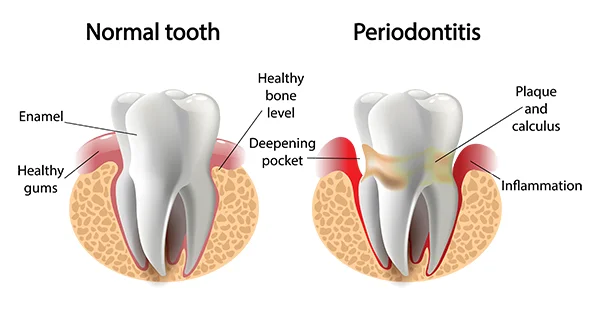Gum Control
Posted on 5/29/2024 by Team at East Portland Dentistry |
 When a stick of chewing gum loses its flavor or texture, we simply discard it. Yet, when our gums no longer function properly, the solution isn’t so simple. Periodontal disease, or gum disease, leads to tooth loss and has been linked to bacterial pneumonia, diabetes, cardiovascular disease, and stroke. The dentists and hygienists at East Portland Dentistry team with you to prevent or treat periodontal disease. When a stick of chewing gum loses its flavor or texture, we simply discard it. Yet, when our gums no longer function properly, the solution isn’t so simple. Periodontal disease, or gum disease, leads to tooth loss and has been linked to bacterial pneumonia, diabetes, cardiovascular disease, and stroke. The dentists and hygienists at East Portland Dentistry team with you to prevent or treat periodontal disease.
Around the Tooth
Periodontal means “around the tooth.” Healthy gum tissue is described as fitting around each tooth like a cuff. When the cuff no longer fits snugly, a pocket develops, allowing harmful bacteria to reach the tooth and bone. Certain bacteria in plaque, which is the sticky film that forms on teeth and surfaces lining the mouth, trigger toxins and enzymes that irritate gums. Plaque hardens into rough, porous deposits known as calculus or tartar. While tartar isn’t the primary cause of periodontal diseases, the pores in tartar trap bacteria and toxins that lead to gum inflammation. Inflammation can damage the gum’s attachment to the tooth and bone, causing periodontal disease.
Be Aware of Warning Signs
Though it’s possible to have periodontal disease without overt symptoms, we at East Portland Dentistry want our patients to be aware of the warning signs:
| • |
Red, tender, or swollen gums that bleed easily
|
| • |
Gums that have pulled away from the teeth
|
| • |
Pus between the teeth and gums
|
| • |
Loose or separating teeth
|
| • |
Changes in the way your teeth or partial dentures fit together when you bite
|
| • |
Persistent bad breath |
To potentially reverse or slow the progression of periodontal disease, please contact East Portland Dentistry if you are experiencing any of the above warning signs. Our dentists can check for, diagnose, and treat periodontal disease. To check for periodontal disease, we use a periodontal probe to gently measure the depth of the sulcus (the v-shaped crevice where the gum line meets the tooth). In healthy teeth, this depth generally does not exceed three millimeters. If your gums have developed pockets, the periodontal probe will indicate the depth. Generally, the more advanced the disease, the deeper the pockets.
Many Types of Gum Disease
There are many types of periodontal diseases, all of which the dentists at East Portland Dentistry can diagnose. The mildest form is gingivitis. Gingivitis causes gums to become red, swollen, and bleed easily. With professional treatment and good oral care at home including twice daily brushing and flossing, gingivitis is reversible. Should your diagnosis be chronic, aggressive, or necrotizing periodontal disease, it is imperative to begin treatment right away. The dentists at East Portland Dentistry can help treat the more severe forms of gum disease through a special cleaning that is called scaling and root cleaning. Through this procedure, the dentist removes plaque and tartar deposits on the tooth and root surfaces, thus allowing the gum tissue to heal and the pockets to shrink. If, however, the pockets do not shrink to your dentist’s satisfaction, you may be referred to a periodontist for surgery.
At East Portland Dentistry, your Gateway dentists of choice. we want your gums to last a lifetime. Your gums are not disposable like a stick of chewing gum. We encourage you to practice proper oral hygiene: brush twice daily with fluoride toothpaste, floss daily, use an anti-microbial mouthwash to help control gingivitis and plaque above the gum line, and visit your dentist regularly for professional cleanings. Together, you and your dentist at East Portland Dentistry can promote gum control. |
|
